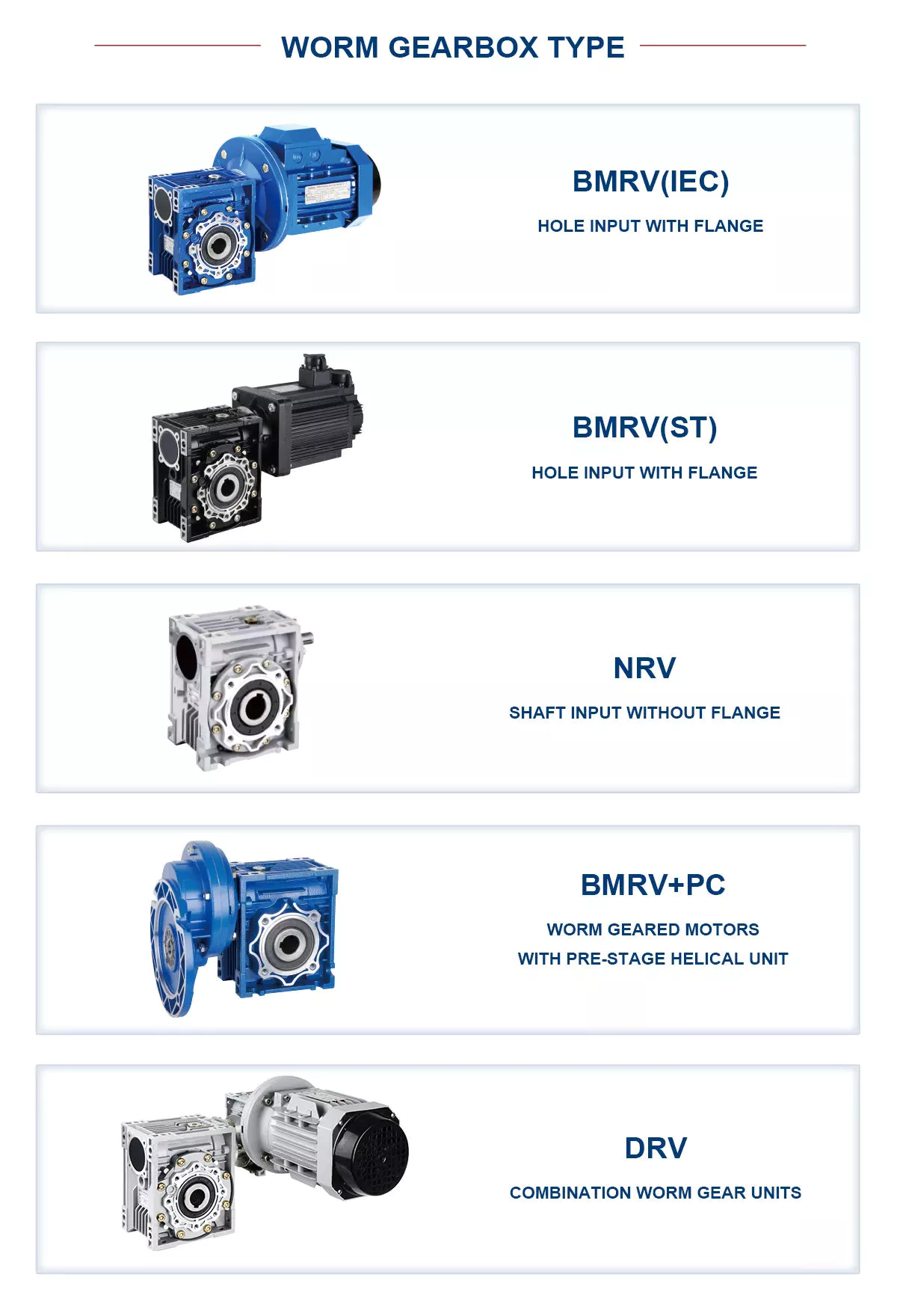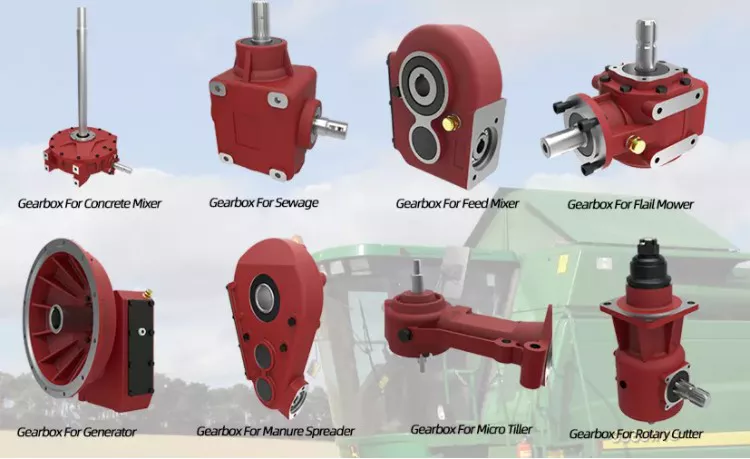Warranty: 1 year
Applicable Industries: Hotels, Garment Shops, Building Content Shops, Production Plant, Machinery Mend Retailers, Foods & Beverage Manufacturing facility, Farms, Cafe, Home Use, Retail, Foods Store, Printing Stores, Design works , Power & Mining, Meals & Beverage Shops, Other, Advertising Business, Manufacturing facility
Excess weight (KG): one hundred
Customized support: OEM, ODM, OBM
Gearing Arrangement: Worm
Output Torque: 2.7~1,760N.m
Input Velocity: 1400(4pole)
Output Velocity: 14-280rpm
Ratio: 5,7.5,ten,15,twenty,twenty five,30,40,50,60,80,100
Worm: 20CrMn Ti with carburizing and quenching, floor harness is fifty six-62HRC
Worm Gear: Copper-ten-3#
Packaging Information: regular export packing
Port: ZheJiang or HangZhou
NMRV +NRV little Worm Equipment Reducer Worm Gearboxes
RV sequence worm pace reducer,One ,double and universal velocity reducer.
one Higher top quality, It adopts difficult tooth equipment with higher accuracy2 Massive output torque,steady transmission with lower noise3 Higher heat-radiating effectiveness,classy form,sturdy provider daily life 4,Appropriate for omni-bearing installation4 Minimal sounds and sleek running5 Worm drive utilizes hollow flank worm6 Higher loading capability, minimal in temperature rise and the long valuable life7 Couple of distinction in between transmission ratio fee, I = 6~138008 Compact framework, modest dimensions, hassle-free maintenance9 Are dependent the special modulation blend system, so its convenient for them to fit all sorts of motors or to link with other electrical power input. The exact same sort of reducer can fit motors with various energy, so that its feasible for distinct varieties of equipment to blend or connect.
The gearboxes can be applied to numerous industrial location, these kinds of as Metallurgical, mines, lifting, transportation, petrochemical, building, textile, pharmaceutical, foodstuff, environmental, light-weight electric powered, plastic machine, paper, parking equipment and so on. Our specialized engineers can select design for you in accordance to your Request, and we also can supply our manufacturing facility catalogue for your reference.
Worm Equipment Speed Reducer/ gearbox
Specificatiion
| Types | Rated Energy | Rated Ratio | Input Hole Dia. | Input Shaft Dia. | Output Gap Dia. | Output Shaft Dia. |
| RV571 | .06KW~.12KW | five~60 | Φ9 | Φ9 | Φ11 | Φ11 |
| RV030 | .06KW~.25KW | 5~eighty | Φ9(Φ11) | Φ9 | Φ14 | Φ14 |
| RV040 | .09KW~.55KW | five~100 | Φ9(Φ11,Φ14) | Φ11 | Φ18(Φ19) | Φ18 |
| RV050 | .12KW~1.5KW | 5~a hundred | Φ11(Φ14,Φ19) | Φ14 | Φ25(Φ24) | Φ25 |
| RV063 | .18KW~2.2KW | seven.5~a hundred | Φ14(Φ19,Φ24) | Φ19 | Φ25(Φ28) | Φ25 |
| RV075 | .25KW~4.0KW | seven.5~one hundred | Φ14(Φ19,Φ24,Φ28) | Φ24 | Φ28(Φ35) | Φ28 |
| RV090 | .37KW~4.0KW | seven.5~100 | Φ19(Φ24,Φ28) | Φ24 | Φ35(Φ38) | Φ35 |
| RV110 | .55KW~7.5KW | 7.5~100 | Φ19(Φ24,Φ28,Φ38) | Φ28 | Φ42 | Φ42 |
| RV130 | .75KW~7.5KW | seven.5~100 | Φ24(Φ28,Φ38) | Φ30 | Φ45 | Φ45 |
| RV150 | two.2KW~15KW | 7.5~100 | Φ28(Φ38,Φ42) | Φ35 | Φ50 | Φ50 |
Firm Information
Packaging & Transport
FAQ
one. How to choose a gearbox which fulfills our need?
You can refer to our catalogue to choose the gearbox or we can help to select when you supply
the complex information of needed output torque, output speed and motor parameter and many others.
2. What information shall we give prior to positioning a purchase purchase?
a) Variety of the gearbox, ratio, input and output variety, enter flange, mounting placement, and motor informationetc.
b) Housing shade.
c) Buy quantity.
d) Other specific needs.
3. Can we acquire 1 computer of every single item for good quality tests?
Of course, we are glad to accept trial order for top quality testing
4. How extended is your shipping and delivery time?
Generally it is 5-ten days if the merchandise are in stock. or it is fifteen-twenty days if the items are not in stock.
Get in touch with Us
Choosing a Gearbox For Your Application
The gearbox is an essential part of bicycles. It is used for several purposes, including speed and force. A gearbox is used to achieve one or both of these goals, but there is always a trade-off. Increasing speed increases wheel speed and forces on the wheels. Similarly, increasing pedal force increases the force on the wheels. This makes it easier for cyclists to accelerate their bicycles. However, this compromise makes the gearbox less efficient than an ideal one.
Dimensions
Gearboxes come in different sizes, so the size of your unit depends on the number of stages. Using a chart to determine how many stages are required will help you determine the dimensions of your unit. The ratios of individual stages are normally greater at the top and get smaller as you get closer to the last reduction. This information is important when choosing the right gearbox for your application. However, the dimensions of your gearbox do not have to be exact. Some manufacturers have guides that outline the required dimensions.
The service factor of a gearbox is a combination of the required reliability, the actual service condition, and the load that the gearbox will endure. It can range from 1.0 to 1.4. If the service factor of a gearbox is 1.0, it means that the unit has just enough capacity to meet your needs, but any extra requirements could cause the unit to fail or overheat. However, service factors of 1.4 are generally sufficient for most industrial applications, since they indicate that a gearbox can withstand 1.4 times its application requirement.
Different sizes also have different shapes. Some types are concentric, while others are parallel or at a right angle. The fourth type of gearbox is called shaft mount and is used when mounting the gearbox by foot is impossible. We will discuss the different mounting positions later. In the meantime, keep these dimensions in mind when choosing a gearbox for your application. If you have space constraints, a concentric gearbox is usually your best option.
Construction
The design and construction of a gearbox entails the integration of various components into a single structure. The components of a gearbox must have sufficient rigidity and adequate vibration damping properties. The design guidelines note the approximate values for the components and recommend the production method. Empirical formulas were used to determine the dimensions of the various components. It was found that these methods can simplify the design process. These methods are also used to calculate the angular and axial displacements of the components of the gearbox.
In this project, we used a 3D modeling software called SOLIDWORKS to create a 3-D model of a gear reducer. We used this software to simulate the structure of the gearbox, and it has powerful design automation tools. Although the gear reducer and housing are separate parts, we model them as a single body. To save time, we also removed the auxiliary elements, such as oil inlets and oil level indicators, from the 3D model.
Our method is based on parameter-optimized deep neural networks (DBNs). This model has both supervised and unsupervised learning capabilities, allowing it to be self-adaptive. This method is superior to traditional methods, which have poor self-adaptive feature extraction and shallow network generalization. Our algorithm is able to recognize faults in different states of the gearbox using its vibration signal. We have tested our model on two gearboxes.
With the help of advanced material science technologies, we can now manufacture the housing for the gearbox using high-quality steel and aluminium alloys. In addition, advanced telematics systems have increased the response time of manufacturers. These technologies are expected to create tremendous opportunities in the coming years and fuel the growth of the gearbox housing market. There are many different ways to construct a gearbox, and these techniques are highly customizable. In this study, we will consider the design and construction of various gearbox types, as well as their components.
Working
A gearbox is a mechanical device that transmits power from one gear to another. The different types of gears are called planetary gears and are used in a variety of applications. Depending on the type of gearbox, it may be concentric, parallel, or at a right angle. The fourth type of gearbox is a shaft mount. The shaft mount type is used in applications that cannot be mounted by foot. The various mounting positions will be discussed later.
Many design guidelines recommend a service factor of 1.0, which needs to be adjusted based on actual service conditions. This factor is the combined measure of external load, required reliability, and overall gearbox life. In general, published service factors are the minimum requirements for a particular application, but a higher value is necessary for severe loading. This calculation is also recommended for high-speed gearboxes. However, the service factor should not be a sole determining factor in the selection process.
The second gear of a pair of gears has more teeth than the first gear. It also turns slower, but with greater torque. The second gear always turns in the opposite direction. The animation demonstrates this change in direction. A gearbox can also have more than one pair of gears, and a first gear may be used for the reverse. When a gear is shifted from one position to another, the second gear is engaged and the first gear is engaged again.
Another term used to describe a gearbox is “gear box.” This term is an interchangeable term for different mechanical units containing gears. Gearboxes are commonly used to alter speed and torque in various applications. Hence, understanding the gearbox and its parts is essential to maintaining your car’s performance. If you want to extend the life of your vehicle, be sure to check the gearbox’s efficiency. The better its functioning, the less likely it is to fail.
Advantages
Automatic transmission boxes are almost identical to mechanical transmission boxes, but they also have an electronic component that determines the comfort of the driver. Automatic transmission boxes use special blocks to manage shifts effectively and take into account information from other systems, as well as the driver’s input. This ensures accuracy and positioning. The following are a few gearbox advantages:
A gearbox creates a small amount of drag when pedaling, but this drag is offset by the increased effort to climb. The external derailleur system is more efficient when adjusted for friction, but it does not create as little drag in dry conditions. The internal gearbox allows engineers to tune the shifting system to minimize braking issues, pedal kickback, and chain growth. As a result, an internal gearbox is a great choice for bikes with high-performance components.
Helical gearboxes offer some advantages, including a low noise level and lower vibration. They are also highly durable and reliable. They can be extended in modular fashion, which makes them more expensive. Gearboxes are best for applications involving heavy loads. Alternatively, you can opt for a gearbox with multiple teeth. A helical gearbox is more durable and robust, but it is also more expensive. However, the benefits far outweigh the disadvantages.
A gearbox with a manual transmission is often more energy-efficient than one with an automatic transmission. Moreover, these cars typically have lower fuel consumption and higher emissions than their automatic counterparts. In addition, the driver does not have to worry about the brakes wearing out quickly. Another advantage of a manual transmission is its affordability. A manual transmission is often available at a lower cost than its automatic counterpart, and repairs and interventions are easier and less costly. And if you have a mechanical problem with the gearbox, you can control the fuel consumption of your vehicle with appropriate driving habits.
Application
While choosing a gearbox for a specific application, the customer should consider the load on the output shaft. High impact loads will wear out gear teeth and shaft bearings, requiring higher service factors. Other factors to consider are the size and style of the output shaft and the environment. Detailed information on these factors will help the customer choose the best gearbox. Several sizing programs are available to determine the most appropriate gearbox for a specific application.
The sizing of a gearbox depends on its input speed, torque, and the motor shaft diameter. The input speed must not exceed the required gearbox’s rating, as high speeds can cause premature seal wear. A low-backlash gearbox may be sufficient for a particular application. Using an output mechanism of the correct size may help increase the input speed. However, this is not recommended for all applications. To choose the right gearbox, check the manufacturer’s warranty and contact customer service representatives.
Different gearboxes have different strengths and weaknesses. A standard gearbox should be durable and flexible, but it must also be able to transfer torque efficiently. There are various types of gears, including open gearing, helical gears, and spur gears. Some of the types of gears can be used to power large industrial machines. For example, the most popular type of gearbox is the planetary drive gearbox. These are used in material handling equipment, conveyor systems, power plants, plastics, and mining. Gearboxes can be used for high-speed applications, such as conveyors, crushers, and moving monorail systems.
Service factors determine the life of a gearbox. Often, manufacturers recommend a service factor of 1.0. However, the actual value may be higher or lower than that. It is often useful to consider the service factor when choosing a gearbox for a particular application. A service factor of 1.4 means that the gearbox can handle 1.4 times the load required. For example, a 1,000-inch-pound gearbox would need a 1,400-inch-pound gearbox. Service factors can be adjusted to suit different applications and conditions.


editor by czh




